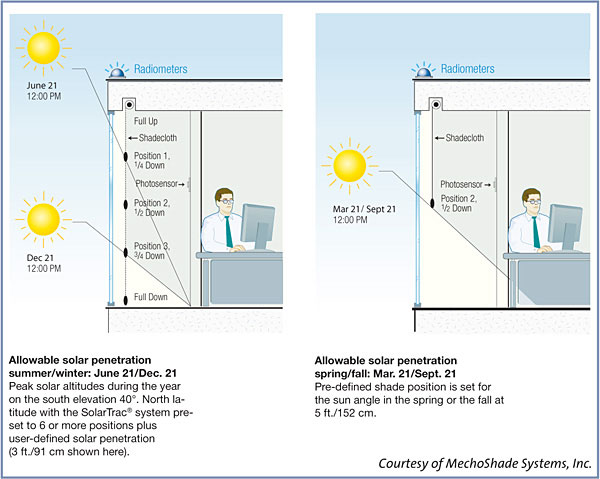Daylight Savings: Window Systems Deliver Light and Reduced Energy Costs
The New York Times Company's new world headquarters designed by Renzo Piano features an 800-foot glass curtain wall to provide natural daylight to occupants. Computer-controlled shades respond to the sun's angle and intensity, and are fully integrated with the dimmable lighting system for maximum daylight benefits while mitigating solar heat gain and glare. The computer model developed by the shade manufacturer was measured and confirmed by the Lawrence Berkeley Labs in an extensive 4,500-foot mock up of a full quarter of a building floor, complete with curtain wall.

"The automated shades at The New York Times Building are the gate keepers for natural light," says Glenn Hughes, President, Glenn D. Hughes Consulting Associates, Director of Construction for the building. "They are raised 72 percent of the time, providing the employees lots of natural light and views. When the shades are down they provide protection from direct solar radiation and glare yet they still allow natural light into the space. The shades make it possible to take full advantage of the floor-to-ceiling, clear glass facade."
According to Berman, the New York Times insisted on wide access to overriding options, enabling users to have the last say in positioning the shades via touch screens on each floor. During a six month time period of data analysis of the daylight integration systems at the New York Times, the office occupants left the shades in the automated position 90 percent of the time. A review of the remaining 10 percent that were manual overrides shows that two-thirds of the shades were moved up and one-third of the shades were moved down. "The performance reporting features in the automated shade computer systems can help identify common characteristics in overrides to determine whether further refinement to settings is warranted - without jeopardizing the 90 percent approval rate during the analyzed time period for this project," says Berman.
The sustainability of mechanized shades can be increased even further by the shade fabric chosen. For its new Washington, D.C. headquarters, seeking LEED platinum designation, the U.S. Green Building Council selected automated solar tracking shades with a fabric woven from a PVC-free thermoplastic olefin and certified Cradle to Cradleâ„¢ Silver by MBDC, formerly known as McDonough Braungard Design Chemistry, which reviews products of chemical inputs down to 100 parts per million; products and building materials so certified have the potential to earn LEED Innovation in Design credits.
While solar-tracked automated shades systems are primarily deployed in large-scale applications, manufacturers have recently launched less costly, scaled-down versions for use in schools, small offices and individual homes. "Why should school kids be distracted by excessive glare and heat if the technology is there to prevent it?" says Berman.
Exterior Shading
Particularly in hot climates, the advantage of exterior shading devices such as light shelves, overhangs, awnings and louvers is that they decrease heat gain and diffuse natural light before entering the building. Direct sun pouring in a window can cause glare on a work station or computer monitor. Focused in one spot, the intense sunlight can cause discomfort, but it can be an advantage if diffused throughout the room.
While shading will "tame" the sunlight but leave potential daylighting power outside the building, light shelves bounce the sunlight up onto the ceiling where it is reflected down deeper into the interior space, with the redirected sunlight reducing the need for artificial lighting and thus conserving energy.
Besides light penetration, light shelves also offer a slight reduction in light near the window, decreasing contrast further into the room away from the window. Light shelves are at their most effective when used on the sunny southern side of a building and with tall or clerestory windows and in daylighting zones along exterior walls. Also, light shelves work best to deflect the high solar angle of the summer sun. How wide a zone a light shelf system can effectively daylight depends on several factors including window height and orientation, time of day and location of the building. The daylit zone may extend inward up to 20 feet, and deeper with a very tall window. "Exterior sunshades can be designed to add to the aesthetic of a building," says Pella's Zeimetz.









